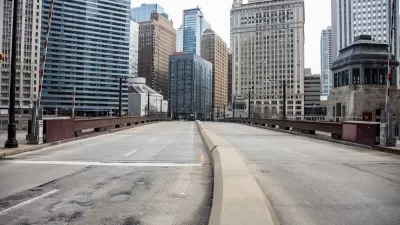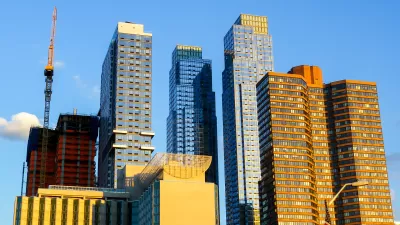Phoenix has the zoning for more height in its downtown, and future development might finally yield a more recognizable skyline.

Grace Oldham reports from Phoenix to explain the city's short building stock compared to many other cities of comparable population and preview how recent zoning code changes could yield taller buildings on the city's skyline.
Oldham interviews Joshua Bednarek, Phoenix's deputy director of planning, on the subject of the city's shorter skyline. Bednarek gives credit to the automobile for spreading the city out, and preventing the development of a vertical downtown. "With infrastructure and technology allowing increased accessibility to the entire Valley, residential and business patterns never created pressure to develop work and living space in the city's core," writes Oldham.
The city also planned for a "village system" in the 1980s, spreading its highest buildings around the city, further ensuring that the city lacks big, signature skyscrapers. Still, Downtown Phoenix has emerged "as the hub of the polycentric system today much more so than in the past," according to Bednarek, and zoning changes in 2010 and 2015 could encourage new height in the downtown core.
FULL STORY: 'Polycentric city': Why doesn't downtown Phoenix have more skyscrapers?

Alabama: Trump Terminates Settlements for Black Communities Harmed By Raw Sewage
Trump deemed the landmark civil rights agreement “illegal DEI and environmental justice policy.”

Planetizen Federal Action Tracker
A weekly monitor of how Trump’s orders and actions are impacting planners and planning in America.

The 120 Year Old Tiny Home Villages That Sheltered San Francisco’s Earthquake Refugees
More than a century ago, San Francisco mobilized to house thousands of residents displaced by the 1906 earthquake. Could their strategy offer a model for the present?

In Both Crashes and Crime, Public Transportation is Far Safer than Driving
Contrary to popular assumptions, public transportation has far lower crash and crime rates than automobile travel. For safer communities, improve and encourage transit travel.

Report: Zoning Reforms Should Complement Nashville’s Ambitious Transit Plan
Without reform, restrictive zoning codes will limit the impact of the city’s planned transit expansion and could exclude some of the residents who depend on transit the most.

Judge Orders Release of Frozen IRA, IIJA Funding
The decision is a victory for environmental groups who charged that freezing funds for critical infrastructure and disaster response programs caused “real and irreparable harm” to communities.
Urban Design for Planners 1: Software Tools
This six-course series explores essential urban design concepts using open source software and equips planners with the tools they need to participate fully in the urban design process.
Planning for Universal Design
Learn the tools for implementing Universal Design in planning regulations.
Clanton & Associates, Inc.
Jessamine County Fiscal Court
Institute for Housing and Urban Development Studies (IHS)
City of Grandview
Harvard GSD Executive Education
Toledo-Lucas County Plan Commissions
Salt Lake City
NYU Wagner Graduate School of Public Service





























